NOTES
OVERVIEW
This is the final issue of this electronic product. It is intended that future state and territory-specific data will be made available in spreadsheet format with releases of the relevant annual national publications.
This electronic product provides a demographic overview of the Northern Territory, 2004. It contains summary tables and commentary on trends in the components of population change including births, deaths and migration. Marriages, divorces, estimated resident population and various demographic rates are also presented. Population and migration data are for the year ended 30 June 2004, while births, deaths, marriages and divorces data are for the year ended 31 December 2004. More recent data are released quarterly in Australian Demographic Statistics (cat. no. 3101.0).
For comparisons between the states and territories of Australia, please refer to Demography, Australia, 2004 (cat. no. 3311.0.55.001). Demography publications for each state and territory can be accessed from the Related Information tab at the top of this page. Additional state demographic data are also available from publications and data cubes linked at the top of this page. The Demography Theme Page provides links to other Australian as well as international demographic statistics. The National Regional Profiles provide economic and social statistics of Statistical Local Areas and Local Government Areas of Australia.
INQUIRIES
For further information about these and related statistics, contact the National Information and Referral Service on 1300 135 070 or Sue Ward on Darwin (08) 8943 2104.
SUMMARY COMMENTARY
INTRODUCTION
The Northern Territory accounted for 1.0% (199,800 persons) of the total Australian estimated resident population at 30 June 2004. The Northern Territory had the highest crude birth rate, highest total fertility rate and highest net reproduction rate of all states and territories in 2004.
POPULATION
In the 12 months to 30 June 2004, the Northern Territory resident population was estimated to have increased by 1,300 persons and reached 199,800 (105,200 males and 94,600 females). The Northern Territory continues to have the highest male to female sex ratio of all states and territories, with 111.2 males per 100 females. Over the ten years to 30 June 2004, the estimated resident population of the Northern Territory increased by 26,500 persons (15.3%).
The rate of growth of the Northern Territory population was 0.7% in 2004. This growth was composed of a natural increase of 2,800 persons, a net overseas migration gain of 650 persons and a net interstate migration loss of 2,100 persons. The Northern Territory's growth rate was lower than the national level of 1.1%, but higher than New South Wales (0.6%), South Australia (0.4%) and the Australian Capital Territory (0.2%).
POPULATION COMPONENTS, Northern Territory - 1994-2004
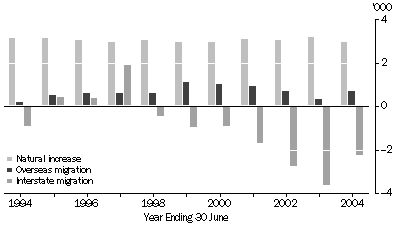
POPULATION AND HOUSEHOLDS, Northern Territory - Selected years at 30 June |
|  |
 |  |  | 1994 | 2003 | 2004 |  |
|  |
| Estimated resident population | ('000) | 173.4 | 198.5 | 199.8 |  |
| Components of population change(a) |  |  |  |  |  |
 | Natural increase(b) | no. | 2 880 | 2 943 | 2 750 |  |
 | Net overseas migration | no. | 195 | 325 | 648 |  |
 | Net interstate migration | no. | -875 | -3 389 | -2 108 |  |
| Total increase(a)(c) | no. | 2 641 | -121 | 1 290 |  |
| Annual growth rate(a) | % | 1.55 | -0.06 | 0.65 |  |
| Estimated resident households(d) | ('000) | 59.0 | nya | nya |  |
| Projected households(e) | ('000) | . . | 63.9 | 64.8 |  |
|  |
| . . not applicable |
| nya not yet available |
| (a) From 30 June previous year. |
| (b) Excess of births over deaths. Births and deaths figures used to compile natural increase for population estimates are based on year of occurrence and may differ from births and deaths data based on year of registration displayed in the Births and Deaths sections of this paper. |
| (c) Includes intercensal discrepancy not accounted for by natural increase and net migration. |
| (d) Based on 1996 census data. |
| (e) Series II from Household and Family Projections, Australia, 2001-2026 (Cat. no. 3236.0). |
BIRTHS AND CONFINEMENTS
Over the 12 months ending 31 December 2004, there were 3,600 live births registered to mothers usually resident in the Northern Territory. This was a decrease of 6.3% (240) from the number of live births registered in 2003. There were 1,800 male births and 1,700 female births registered in 2004, a sex ratio of 102.9 males born per 100 females. This is the lowest sex ratio for births of all states and territories, and lower than the national sex ratio of 105.6 males born per 100 females. The crude birth rate in 2004 was 17.8 births per 1,000 population, down from 19.1 in 2003, but is still the highest of all states and territories. The national crude birth rate was 12.7 births per 1,000 population.
In 2004, the total fertility rate (TFR), which represents the number of children a female would bear on average during her reproductive lifetime based on current age-specific fertility rates, was 2.24 for the Northern Territory, the highest fertility rate of all states and territories and above the national rate of 1.77. The Northern Territory recorded a much higher fertility rate for women aged 15-19 years (57.8 births per 1,000 women) and 20-24 years (104.6 births per 1,000 women) compared with the national fertility rate for women aged 15-19 years (16.3 per 1,000 women) and 20-24 years (53.4 births per 1,000 women).
AGE-SPECIFIC FERTILITY RATES(a), Northern Territory, Selected age groups - 2002-2004
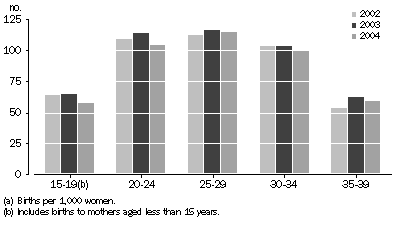
The median age of parents in the Northern Territory was 28.3 years for mothers (all confinements) and 31.8 years for fathers (all fathers where age is known), both below the national median age of 30.6 and 32.8 years respectively.
BIRTHS AND CONFINEMENTS, Northern Territory - Selected years(a) |
|  |
 |  |  | 1994 | 2003 | 2004 |  |
|  |
| Live births |  |  |  |  |  |
 | Number | no. | 3 626 | 3 790 | 3 551 |  |
 | Crude birth rate(b) | rate | 20.9 | 19.1 | 17.8 |  |
 | Total fertility rate(c) | rate | 2.294 | 2.376 | 2.239 |  |
 | Net reproduction rate(d) | rate | 1.115 | 1.108 | 1.072 |  |
| All confinements |  |  |  |  |  |
 | Number | no. | 3 580 | 3 743 | 3 510 |  |
 | Median age of mother | years | 26.7 | 28.2 | 28.3 |  |
| Nuptial confinements |  |  |  |  |  |
 | Number | no. | 1 562 | 1 340 | 1 247 |  |
 | Median age of mother | years | 29.7 | 31.6 | 31.8 |  |
 | Median age of father | years | 32.3 | 33.5 | 33.8 |  |
| First confinements |  |  |  |  |  |
 | Number | no. | 642 | 557 | 532 |  |
 | Median age of mother | years | 28.2 | 30.4 | 30.8 |  |
|  |
| (a) Year of registration. |
| (b) Births per 1,000 population. |
| (c) Births per woman. |
| (d) Daughters surviving to reproductive age per woman. |
DEATHS
In 2004, there were 890 registered deaths of persons usually resident in the Northern Territory, an increase of 2.1% compared with 2003 (880 registered deaths) and an increase of 15.1% from 1994 (780 registered deaths). The 2004 total comprised 560 males and 330 females, a sex ratio of 169.8 male deaths per 100 female deaths. The sex ratio for the Northern Territory continues to be the highest of all states and territories. The national sex ratio is 106.7.
There were 40 infant deaths in the Northern Territory in 2004, with a sex ratio of 171.4 male infant deaths to 100 female infant deaths. The infant mortality rate (IMR) increased from 8.4 deaths per 1,000 live births in 2003 to 10.7 deaths per 1,000 live births in 2004 and remained significantly higher than the national rate of 4.7.
The crude death rate for 2004 was 4.5 deaths per 1,000 of total population. After standardisation for age, the death rate increased to 8.2 deaths per 1,000 of total population in 2004 which was above the national rate of 6.3. The standardised death rate (SDR) for males in the Northern Territory was 9.5 per 1,000 population compared with 6.9 for females. Nationally, the SDR for males was 7.7 and 5.1 for females.
STANDARDISED DEATH RATES(a), Australia and Northern Territory - 1994-2004
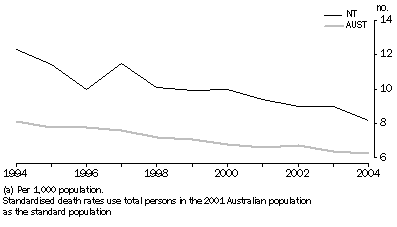
In 2004, both the life expectancy at birth (72.3 years for males and 78.0 years for females) and the median age at death (55.0 years for males and 61.2 years for females) continued to be the lowest of all states and territories.
DEATHS, Northern Territory - Selected years(a) |
|  |
 |  |  | 1994 | 2003 | 2004 |  |
|  |
| Number | no. | 776 | 875 | 893 |  |
| Crude death rate(b) | rate | 4.5 | 4.4 | 4.5 |  |
| Standardised death rate(c) | rate | 12.3 | 9.0 | 8.2 |  |
| Median age at death |  |  |  |  |  |
 | Males | years | 53.8 | 56.7 | 55.0 |  |
 | Females | years | 63.9 | 63.8 | 61.2 |  |
| Infant deaths |  |  |  |  |  |
 | Number | no. | 41 | 32 | 38 |  |
 | Infant mortality rate(d) | rate | 11.3 | 8.4 | 10.7 |  |
| Life expectancy at birth(e) |  |  |  |  |  |
 | Males | years | 68.9 | 72.0 | 72.3 |  |
 | Females | years | 74.3 | 77.3 | 78.0 |  |
|  |
| (a) Year of registration. |
| (b) Deaths per 1,000 population. |
| (c) Deaths per 1,000 population. Standardised death rates use total persons in the 2001 Australian population as the standard population. |
| (d) Deaths per 1,000 live births. |
| (e) From 1995 onwards expectation of life has been calculated using three years of data. |
MIGRATION
For the year ended 30 June 2004, the Northern Territory gained 650 persons through net overseas migration. This was an increase of 99.4% (320 persons) over the preceding year and the first increase in net overseas migration since 1999. The highest net overseas migration figure over the last ten years was 1,000 persons in 1998-99.
NET OVERSEAS MIGRATION, Northern Territory - 1994-2004
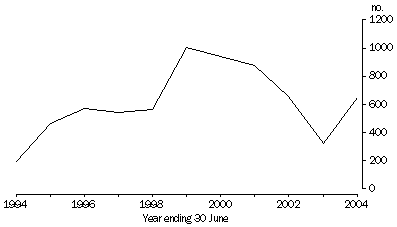
The Northern Territory experienced a further loss from net interstate migration during 2003-04 with 2,100 more people leaving for other states and the Australian Capital Territory than arriving to settle in the Northern Territory. In 2003-04, the largest net loss was to Queensland (1,400) and the largest net gain was from New South Wales (190).
NET INTERSTATE MIGRATION, Northern Territory - at 30 June 2002-2004
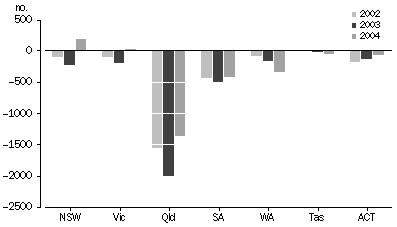
MARRIAGES
There were 780 marriages registered in the Northern Territory in 2004, an increase of 7.5% compared with 2003 (720) and an increase of 1.6% on the number of marriages registered in 1994 (770). The crude marriage rate was 3.9 marriages per 1,000 population, remaining well below the national rate of 5.5. The Northern Territory continued to record the lowest crude marriage rate of all states and territories.
In 2004, the median age at marriage in the Northern Territory was 33.2 years for bridegrooms and 30.5 years for brides. Both of these median ages were higher than the national median age at marriage of 31.5 for bridegrooms and 29.2 for brides and reflects the continuing trend for people to marry later in life.
MARRIAGES, Northern Territory - Selected years |
|  |
 |  |  | 1994 | 2003 | 2004 |  |
|  |
| Number registered | no. | 765 | 723 | 777 |  |
| Crude marriage rate(a) | rate | 4.4 | 3.6 | 3.9 |  |
| Median age at marriage |  |  |  |  |  |
 | Bridegroom | years | 30.8 | 33.1 | 33.2 |  |
 | Bride | years | 27.8 | 30.0 | 30.5 |  |
|  |
| (a) Marriages per 1,000 population. |
DIVORCES
There were 430 divorces granted in the Northern Territory in 2004, a decrease of 11.4% compared with 2003 (490). The crude divorce rate was 2.2 divorces per 1,000 population in 2004. In the ten years to 2004, the crude divorce rate has remained relatively stable.
In 2004, the median duration of marriage for the Northern Territory was 11.8 years, 1.2 years longer than in 1994. The median interval between marriage and final separation has also increased over the same period, from 6.8 years in 1994 to 8.0 years in 2004.
DIVORCES, Northern Territory - Selected years |
|  |
 |  |  | 1994 | 2003 | 2004 |  |
|  |
| Number granted | no. | 400 | 490 | 434 |  |
| Crude divorce rate(a) | rate | 2.3 | 2.5 | 2.2 |  |
| Median duration of marriage |  |  |  |  |  |
 | To separation | years | 6.8 | 8.0 | 8.0 |  |
 | To divorce | years | 10.6 | 11.7 | 11.8 |  |
|  |
| (a) Divorces per 1,000 population. |
THE ABORIGINAL AND TORRES STRAIT ISLANDER POPULATION
This section includes information on births and deaths in the Aboriginal and Torres Strait Islander population (Indigenous population) usually resident in the Northern Territory.
Care needs to be taken when interpreting year-to-year movements in this data due to the relatively small numbers and possible under-recording of Indigenous status in birth and death registrations. No data on the Indigenous population are available for marriages and divorces.
Birth registrations classify a birth as being of Aboriginal and/or Torres Strait Islander origin (Indigenous) where at least one parent identified as being of Indigenous origin. In 2004 there were 1,500 Indigenous registered births in the Northern Territory, which comprised 42.5% of all NT births registered in that year. Indigenous women in the Northern Territory recorded the highest Indigenous fertility rate (2.6 babies per woman) in Australia. High fertility at younger ages contributes to the relatively high fertility of Indigenous women. The fertility rate of Indigenous women aged 15-19 years (110.6 babies per 1,000 women) living in the Northern Territory was nearly twice that of all women aged 15-19 years (57.8 babies per 1,000 women) living in the Northern Territory. In 2004, the median age of Indigenous mothers living in the Northern Territory was of 24.0 years compared to 28.3 years for all Northern Territory mothers.
AGE-SPECIFIC FERTILITY RATES(a), Northern Territory - 2004
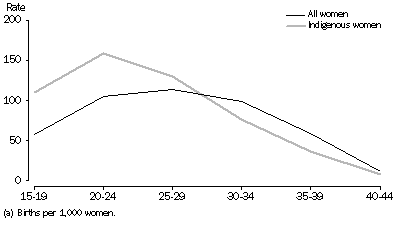
There were 890 deaths registered in the Northern Territory in 2004, and of these 450 (50.3%) were registered where the deceased person was identified as being Indigenous. There were 260 male and 190 female Indigenous deaths registered in the Northern Territory in 2004, giving a sex ratio of 133.9 males for every 100 female deaths. In 2004, the median age at death was 43.8 years for Indigenous males and 54.0 years for Indigenous females. These ages were considerably lower than the median age at death for the non-Indigenous Northern Territory population of 63.0 years for males and 71.3 years for females. In 2004, there were 30 Indigenous infant deaths which comprised 71.1% of the total infant deaths recorded in the Northern Territory.
RELATED LINKS
Demographic data for all statistical local areas of the Northern Territory are available from the data cube linked on the Details tab at the top of this page.
From the Related Information Tab there are links to other releases providing more specific or in-depth analysis and information
 Print Page
Print Page
 Print All
Print All